Engineering Logistics Course 2022
VerifiedAdded on 2022/10/09
|7
|1311
|23
AI Summary
Contribute Materials
Your contribution can guide someone’s learning journey. Share your
documents today.
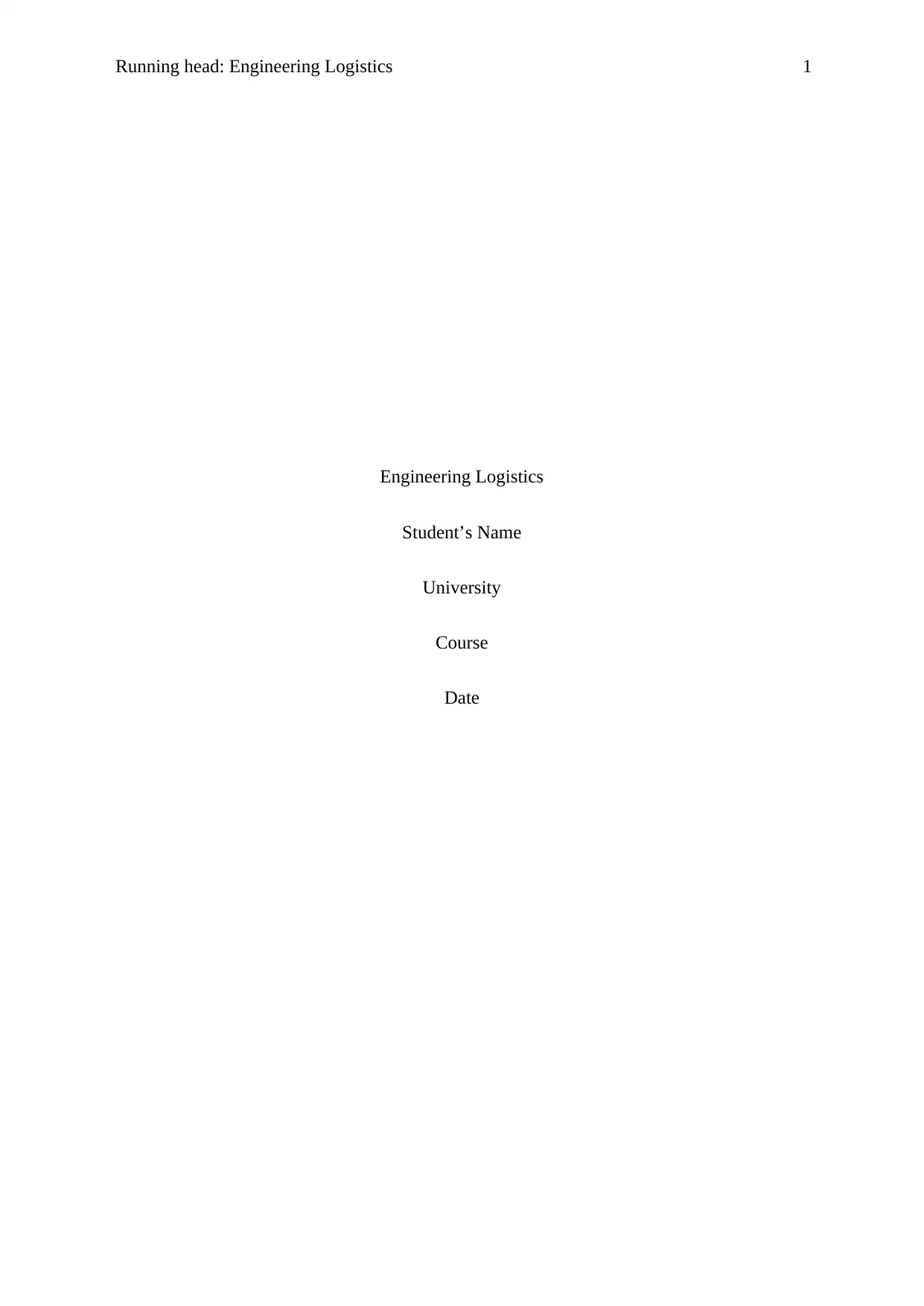
Running head: Engineering Logistics 1
Engineering Logistics
Student’s Name
University
Course
Date
Engineering Logistics
Student’s Name
University
Course
Date
Secure Best Marks with AI Grader
Need help grading? Try our AI Grader for instant feedback on your assignments.
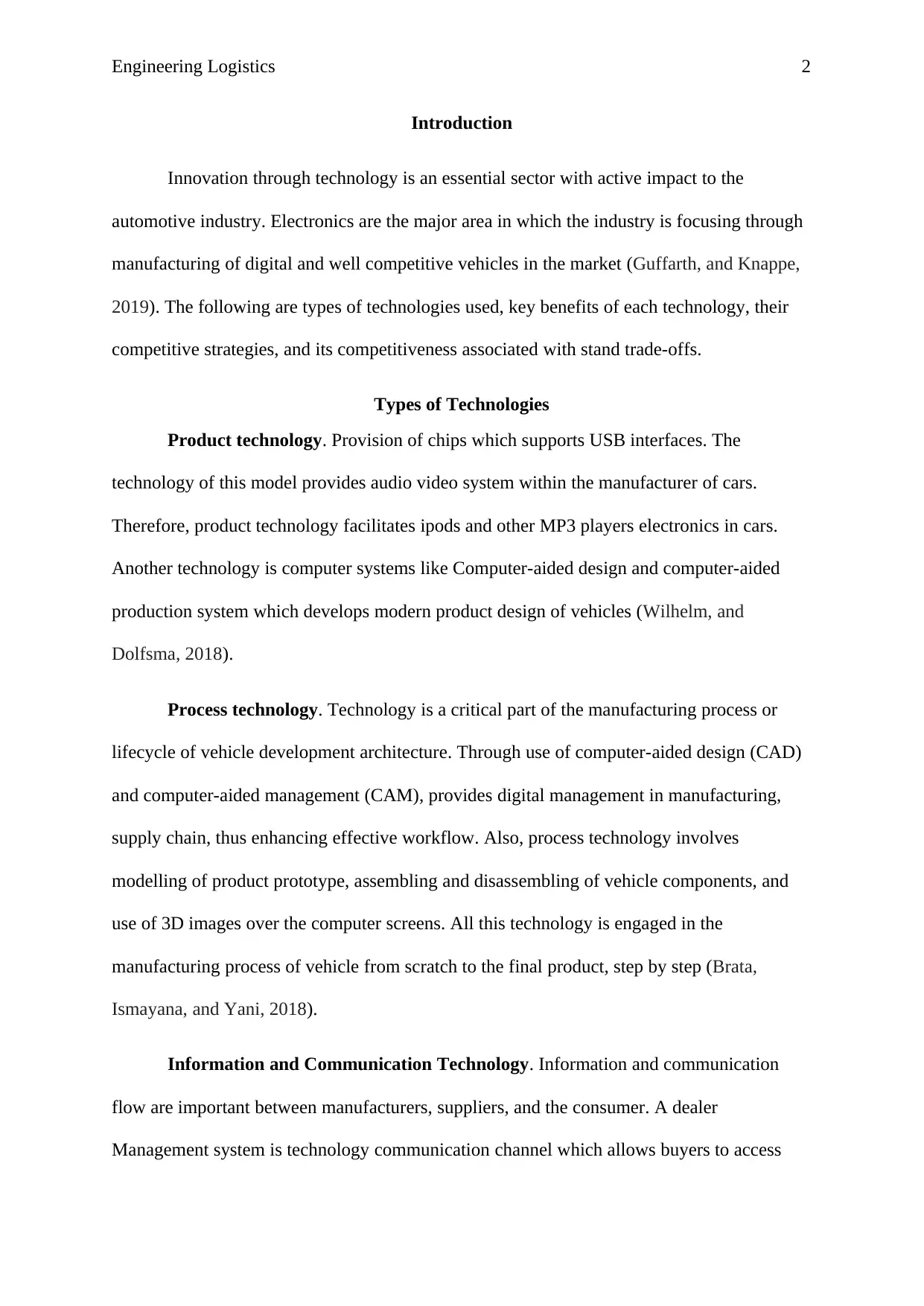
Engineering Logistics 2
Introduction
Innovation through technology is an essential sector with active impact to the
automotive industry. Electronics are the major area in which the industry is focusing through
manufacturing of digital and well competitive vehicles in the market (Guffarth, and Knappe,
2019). The following are types of technologies used, key benefits of each technology, their
competitive strategies, and its competitiveness associated with stand trade-offs.
Types of Technologies
Product technology. Provision of chips which supports USB interfaces. The
technology of this model provides audio video system within the manufacturer of cars.
Therefore, product technology facilitates ipods and other MP3 players electronics in cars.
Another technology is computer systems like Computer-aided design and computer-aided
production system which develops modern product design of vehicles (Wilhelm, and
Dolfsma, 2018).
Process technology. Technology is a critical part of the manufacturing process or
lifecycle of vehicle development architecture. Through use of computer-aided design (CAD)
and computer-aided management (CAM), provides digital management in manufacturing,
supply chain, thus enhancing effective workflow. Also, process technology involves
modelling of product prototype, assembling and disassembling of vehicle components, and
use of 3D images over the computer screens. All this technology is engaged in the
manufacturing process of vehicle from scratch to the final product, step by step (Brata,
Ismayana, and Yani, 2018).
Information and Communication Technology. Information and communication
flow are important between manufacturers, suppliers, and the consumer. A dealer
Management system is technology communication channel which allows buyers to access
Introduction
Innovation through technology is an essential sector with active impact to the
automotive industry. Electronics are the major area in which the industry is focusing through
manufacturing of digital and well competitive vehicles in the market (Guffarth, and Knappe,
2019). The following are types of technologies used, key benefits of each technology, their
competitive strategies, and its competitiveness associated with stand trade-offs.
Types of Technologies
Product technology. Provision of chips which supports USB interfaces. The
technology of this model provides audio video system within the manufacturer of cars.
Therefore, product technology facilitates ipods and other MP3 players electronics in cars.
Another technology is computer systems like Computer-aided design and computer-aided
production system which develops modern product design of vehicles (Wilhelm, and
Dolfsma, 2018).
Process technology. Technology is a critical part of the manufacturing process or
lifecycle of vehicle development architecture. Through use of computer-aided design (CAD)
and computer-aided management (CAM), provides digital management in manufacturing,
supply chain, thus enhancing effective workflow. Also, process technology involves
modelling of product prototype, assembling and disassembling of vehicle components, and
use of 3D images over the computer screens. All this technology is engaged in the
manufacturing process of vehicle from scratch to the final product, step by step (Brata,
Ismayana, and Yani, 2018).
Information and Communication Technology. Information and communication
flow are important between manufacturers, suppliers, and the consumer. A dealer
Management system is technology communication channel which allows buyers to access
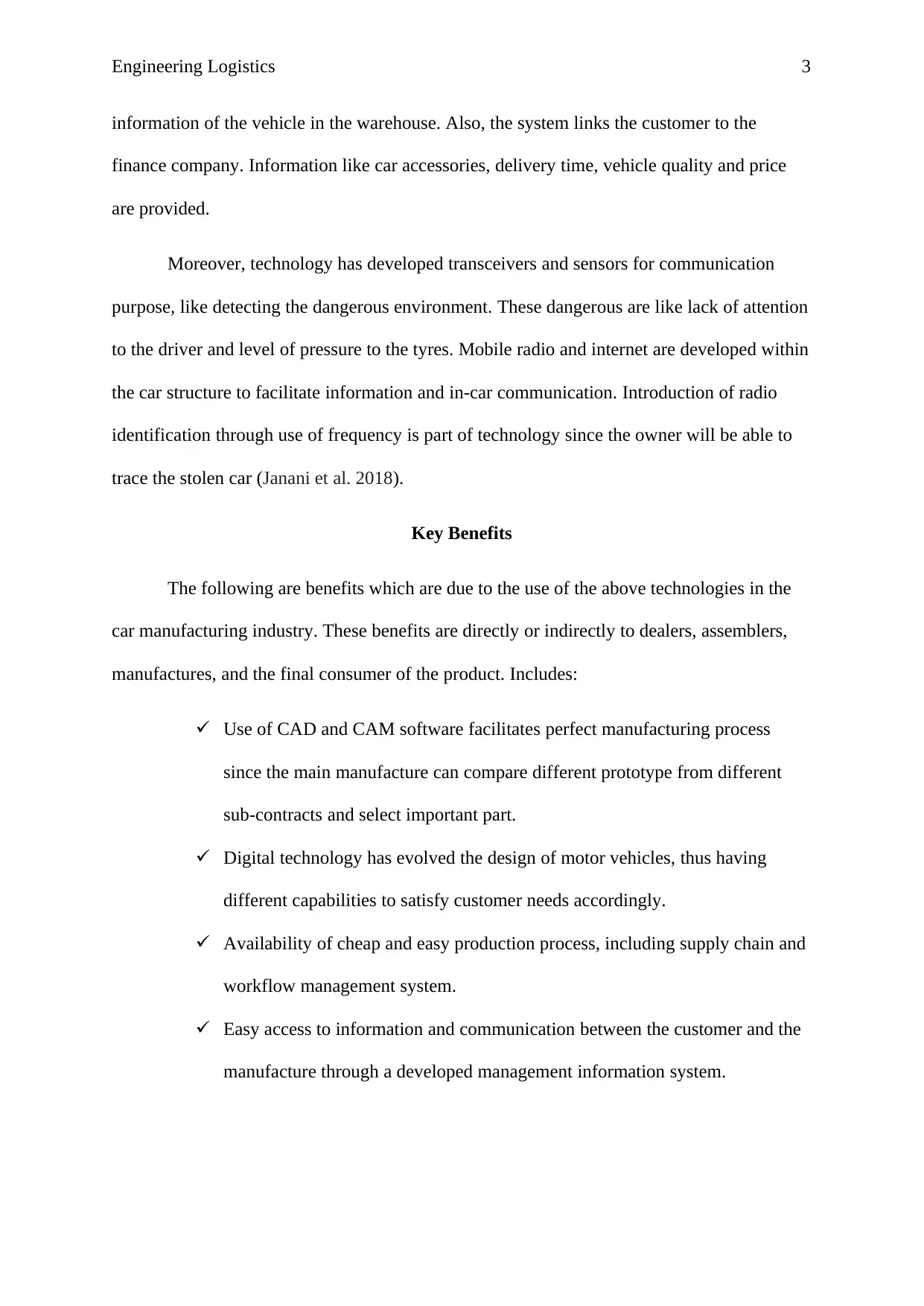
Engineering Logistics 3
information of the vehicle in the warehouse. Also, the system links the customer to the
finance company. Information like car accessories, delivery time, vehicle quality and price
are provided.
Moreover, technology has developed transceivers and sensors for communication
purpose, like detecting the dangerous environment. These dangerous are like lack of attention
to the driver and level of pressure to the tyres. Mobile radio and internet are developed within
the car structure to facilitate information and in-car communication. Introduction of radio
identification through use of frequency is part of technology since the owner will be able to
trace the stolen car (Janani et al. 2018).
Key Benefits
The following are benefits which are due to the use of the above technologies in the
car manufacturing industry. These benefits are directly or indirectly to dealers, assemblers,
manufactures, and the final consumer of the product. Includes:
Use of CAD and CAM software facilitates perfect manufacturing process
since the main manufacture can compare different prototype from different
sub-contracts and select important part.
Digital technology has evolved the design of motor vehicles, thus having
different capabilities to satisfy customer needs accordingly.
Availability of cheap and easy production process, including supply chain and
workflow management system.
Easy access to information and communication between the customer and the
manufacture through a developed management information system.
information of the vehicle in the warehouse. Also, the system links the customer to the
finance company. Information like car accessories, delivery time, vehicle quality and price
are provided.
Moreover, technology has developed transceivers and sensors for communication
purpose, like detecting the dangerous environment. These dangerous are like lack of attention
to the driver and level of pressure to the tyres. Mobile radio and internet are developed within
the car structure to facilitate information and in-car communication. Introduction of radio
identification through use of frequency is part of technology since the owner will be able to
trace the stolen car (Janani et al. 2018).
Key Benefits
The following are benefits which are due to the use of the above technologies in the
car manufacturing industry. These benefits are directly or indirectly to dealers, assemblers,
manufactures, and the final consumer of the product. Includes:
Use of CAD and CAM software facilitates perfect manufacturing process
since the main manufacture can compare different prototype from different
sub-contracts and select important part.
Digital technology has evolved the design of motor vehicles, thus having
different capabilities to satisfy customer needs accordingly.
Availability of cheap and easy production process, including supply chain and
workflow management system.
Easy access to information and communication between the customer and the
manufacture through a developed management information system.

Engineering Logistics 4
Security and robust vehicle are available in the market. Use of scanners like
barcodes facilitates notification of insecurity and danger within the
environment.
The customer enjoys the use of "global positioning equipment" which enables
vehicle track and charges while on road transit.
A vehicle with stability control like BMW and tiny screens are prone to
accidents since they are in-car communication thus facilitating steer-by-wire
and brake-by-wire where possible.
Competitive priorities
These competitive priorities are categorized into two levels, one individual network
level, and the second one is supply network level as a whole. These are competitive strategies
the industry owns.
Individual Supply Network level
A more straightforward system with well-hinted capabilities is achieved through the
use of modern technology like CAD and CAM, which are not familiar to all
manufacturing company.
Product is modelling in three dimensions using the software in between partnering
suppliers, consultants, and resellers of the vehicle which competitive in the industry.
3D images of vehicle components over the screen creates motor-driven stylus to the
users; thus, customer "feeling" modern technology.
Logistics and management issues are complex improved through the use of modern
technology, thus perfecting the manufacturing process between different parties.
Security and robust vehicle are available in the market. Use of scanners like
barcodes facilitates notification of insecurity and danger within the
environment.
The customer enjoys the use of "global positioning equipment" which enables
vehicle track and charges while on road transit.
A vehicle with stability control like BMW and tiny screens are prone to
accidents since they are in-car communication thus facilitating steer-by-wire
and brake-by-wire where possible.
Competitive priorities
These competitive priorities are categorized into two levels, one individual network
level, and the second one is supply network level as a whole. These are competitive strategies
the industry owns.
Individual Supply Network level
A more straightforward system with well-hinted capabilities is achieved through the
use of modern technology like CAD and CAM, which are not familiar to all
manufacturing company.
Product is modelling in three dimensions using the software in between partnering
suppliers, consultants, and resellers of the vehicle which competitive in the industry.
3D images of vehicle components over the screen creates motor-driven stylus to the
users; thus, customer "feeling" modern technology.
Logistics and management issues are complex improved through the use of modern
technology, thus perfecting the manufacturing process between different parties.
Secure Best Marks with AI Grader
Need help grading? Try our AI Grader for instant feedback on your assignments.
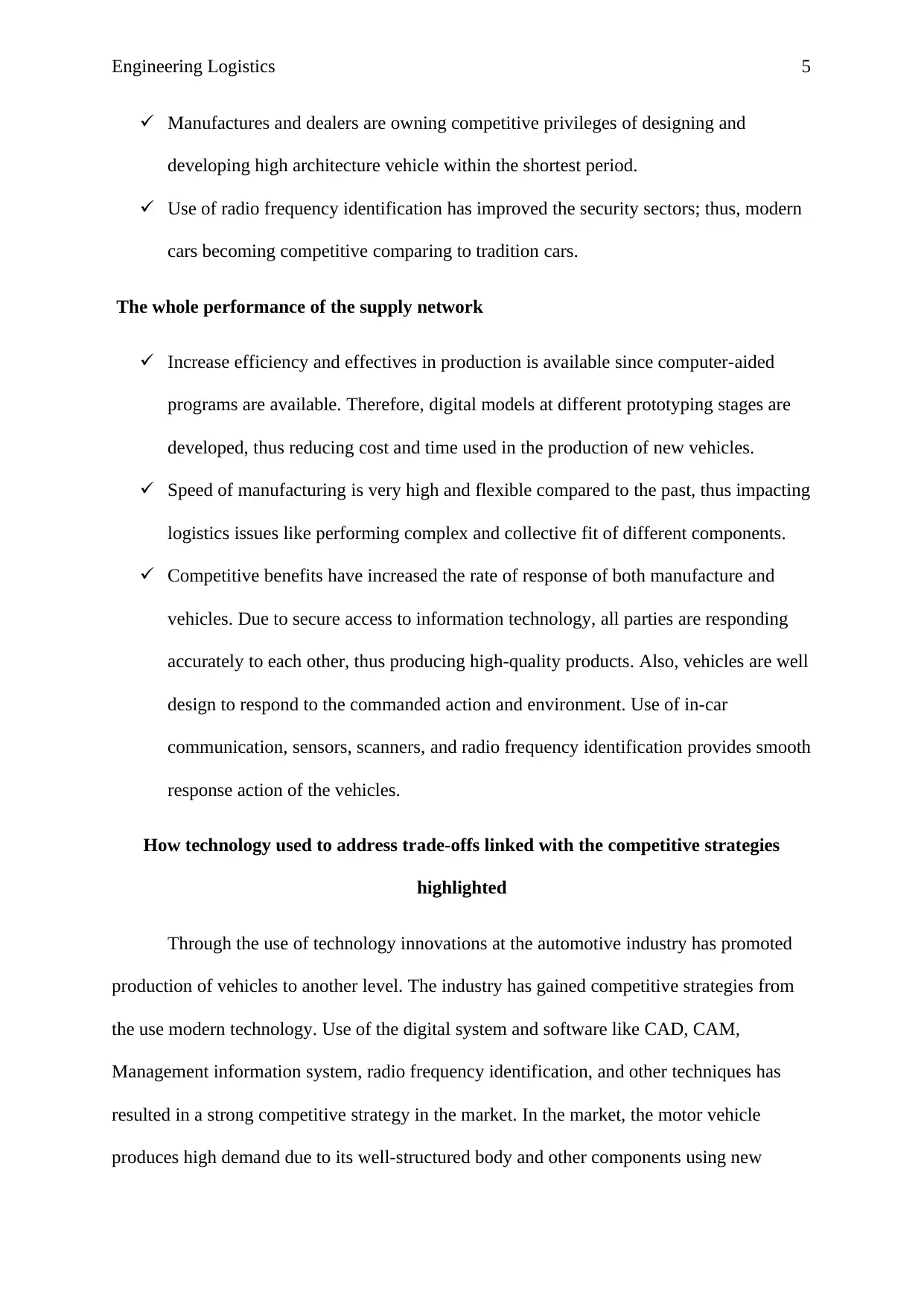
Engineering Logistics 5
Manufactures and dealers are owning competitive privileges of designing and
developing high architecture vehicle within the shortest period.
Use of radio frequency identification has improved the security sectors; thus, modern
cars becoming competitive comparing to tradition cars.
The whole performance of the supply network
Increase efficiency and effectives in production is available since computer-aided
programs are available. Therefore, digital models at different prototyping stages are
developed, thus reducing cost and time used in the production of new vehicles.
Speed of manufacturing is very high and flexible compared to the past, thus impacting
logistics issues like performing complex and collective fit of different components.
Competitive benefits have increased the rate of response of both manufacture and
vehicles. Due to secure access to information technology, all parties are responding
accurately to each other, thus producing high-quality products. Also, vehicles are well
design to respond to the commanded action and environment. Use of in-car
communication, sensors, scanners, and radio frequency identification provides smooth
response action of the vehicles.
How technology used to address trade-offs linked with the competitive strategies
highlighted
Through the use of technology innovations at the automotive industry has promoted
production of vehicles to another level. The industry has gained competitive strategies from
the use modern technology. Use of the digital system and software like CAD, CAM,
Management information system, radio frequency identification, and other techniques has
resulted in a strong competitive strategy in the market. In the market, the motor vehicle
produces high demand due to its well-structured body and other components using new
Manufactures and dealers are owning competitive privileges of designing and
developing high architecture vehicle within the shortest period.
Use of radio frequency identification has improved the security sectors; thus, modern
cars becoming competitive comparing to tradition cars.
The whole performance of the supply network
Increase efficiency and effectives in production is available since computer-aided
programs are available. Therefore, digital models at different prototyping stages are
developed, thus reducing cost and time used in the production of new vehicles.
Speed of manufacturing is very high and flexible compared to the past, thus impacting
logistics issues like performing complex and collective fit of different components.
Competitive benefits have increased the rate of response of both manufacture and
vehicles. Due to secure access to information technology, all parties are responding
accurately to each other, thus producing high-quality products. Also, vehicles are well
design to respond to the commanded action and environment. Use of in-car
communication, sensors, scanners, and radio frequency identification provides smooth
response action of the vehicles.
How technology used to address trade-offs linked with the competitive strategies
highlighted
Through the use of technology innovations at the automotive industry has promoted
production of vehicles to another level. The industry has gained competitive strategies from
the use modern technology. Use of the digital system and software like CAD, CAM,
Management information system, radio frequency identification, and other techniques has
resulted in a strong competitive strategy in the market. In the market, the motor vehicle
produces high demand due to its well-structured body and other components using new

Engineering Logistics 6
technology through innovation (Nazir, and Shavarebi, 2019). The production unit is
systematic, which low cost compared to output which is highly demanding at a high price.
All this increases effective competitive strategies of the industry to the market.
technology through innovation (Nazir, and Shavarebi, 2019). The production unit is
systematic, which low cost compared to output which is highly demanding at a high price.
All this increases effective competitive strategies of the industry to the market.
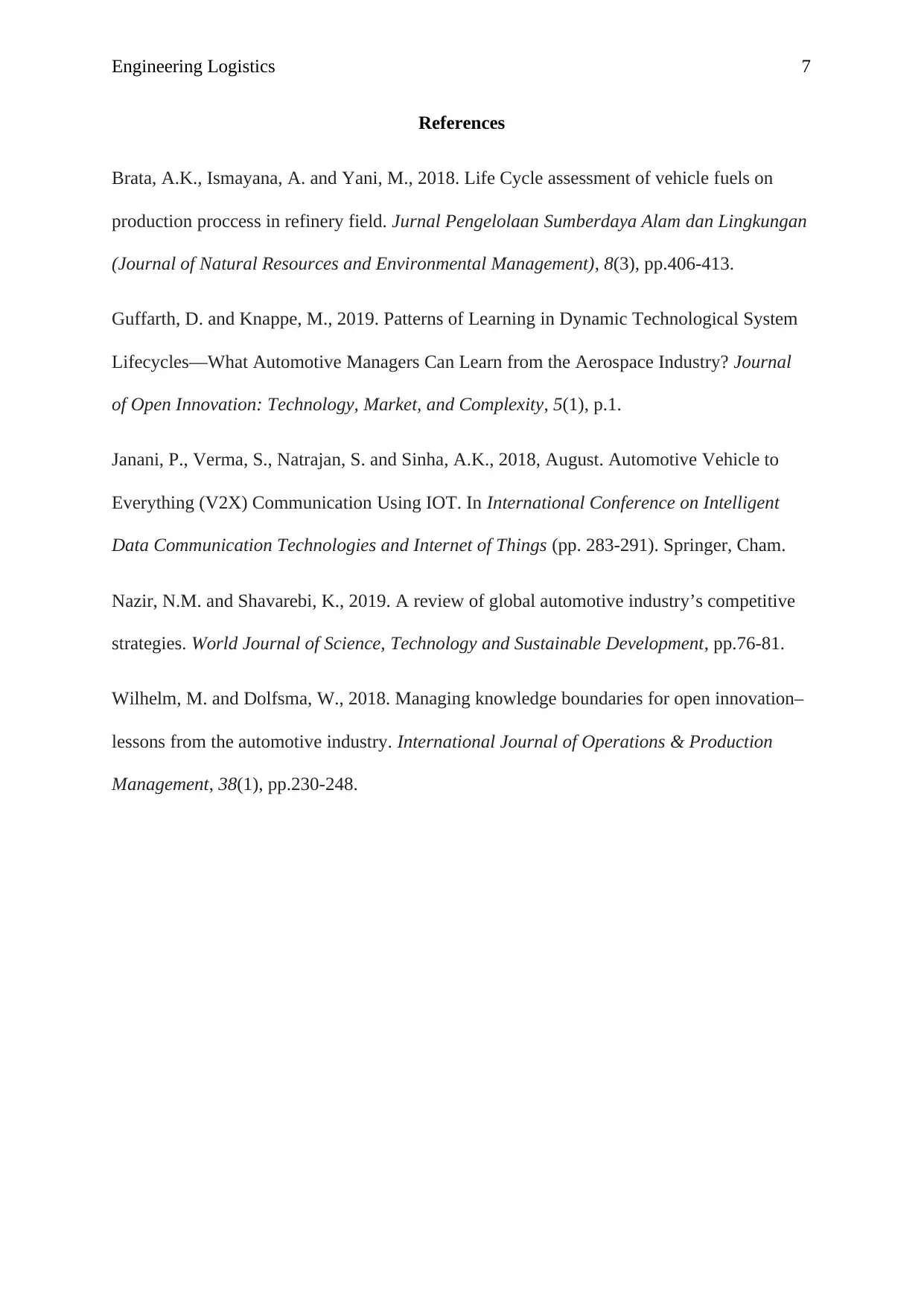
Engineering Logistics 7
References
Brata, A.K., Ismayana, A. and Yani, M., 2018. Life Cycle assessment of vehicle fuels on
production proccess in refinery field. Jurnal Pengelolaan Sumberdaya Alam dan Lingkungan
(Journal of Natural Resources and Environmental Management), 8(3), pp.406-413.
Guffarth, D. and Knappe, M., 2019. Patterns of Learning in Dynamic Technological System
Lifecycles—What Automotive Managers Can Learn from the Aerospace Industry? Journal
of Open Innovation: Technology, Market, and Complexity, 5(1), p.1.
Janani, P., Verma, S., Natrajan, S. and Sinha, A.K., 2018, August. Automotive Vehicle to
Everything (V2X) Communication Using IOT. In International Conference on Intelligent
Data Communication Technologies and Internet of Things (pp. 283-291). Springer, Cham.
Nazir, N.M. and Shavarebi, K., 2019. A review of global automotive industry’s competitive
strategies. World Journal of Science, Technology and Sustainable Development, pp.76-81.
Wilhelm, M. and Dolfsma, W., 2018. Managing knowledge boundaries for open innovation–
lessons from the automotive industry. International Journal of Operations & Production
Management, 38(1), pp.230-248.
References
Brata, A.K., Ismayana, A. and Yani, M., 2018. Life Cycle assessment of vehicle fuels on
production proccess in refinery field. Jurnal Pengelolaan Sumberdaya Alam dan Lingkungan
(Journal of Natural Resources and Environmental Management), 8(3), pp.406-413.
Guffarth, D. and Knappe, M., 2019. Patterns of Learning in Dynamic Technological System
Lifecycles—What Automotive Managers Can Learn from the Aerospace Industry? Journal
of Open Innovation: Technology, Market, and Complexity, 5(1), p.1.
Janani, P., Verma, S., Natrajan, S. and Sinha, A.K., 2018, August. Automotive Vehicle to
Everything (V2X) Communication Using IOT. In International Conference on Intelligent
Data Communication Technologies and Internet of Things (pp. 283-291). Springer, Cham.
Nazir, N.M. and Shavarebi, K., 2019. A review of global automotive industry’s competitive
strategies. World Journal of Science, Technology and Sustainable Development, pp.76-81.
Wilhelm, M. and Dolfsma, W., 2018. Managing knowledge boundaries for open innovation–
lessons from the automotive industry. International Journal of Operations & Production
Management, 38(1), pp.230-248.
1 out of 7
Related Documents
Your All-in-One AI-Powered Toolkit for Academic Success.
+13062052269
info@desklib.com
Available 24*7 on WhatsApp / Email
![[object Object]](/_next/static/media/star-bottom.7253800d.svg)
Unlock your academic potential
© 2024 | Zucol Services PVT LTD | All rights reserved.





